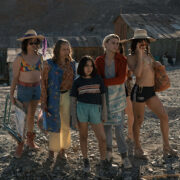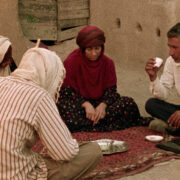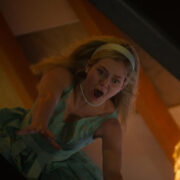Destroying Norway, Again: Interview With THE BURNING SEA Director John Andreas Andersen

Film critic, Ithaca College and University of St Andrews graduate,…
Norway just can’t catch a break. In 2015, Roar Uthaug’s disaster film The Wave premiered to rapturous acclaim and box office success, depicting a rockslide that causes a tsunami in a fjord-side Norwegian town. Director John Andreas Andersen helmed its sequel, The Quake, in 2018, wherein Oslo is devastated by an earthquake. Now, Andersen is premiering a new film: The Burning Sea, a disaster eco-thriller that crosses monumental environmental calamities like the Deepwater Horizon oil spill with the hard-science action spectacle of James Cameron. Among all these disasters, Norway’s constantly getting destroyed on film.
The Burning Sea follows a robotics researcher, Sofia (Kristine Kujath Thorp), who ventures into Norway’s North Sea to rescue her partner, Stian (Henrik Bjelland), after his oil rig collapses. Among its scenes of underwater peril, Andersen blends real-life robotics by way of a snakelike machine, Eelie, that Sofia uses to scout out the wreckage and hopefully find Stian.
I had a chance to speak with Andersen about his film, his experience making disaster movies, and the science and politics beneath The Burning Sea.
This interview has been edited for clarity.
Clement Obropta for Film Inquiry: In your disaster films, there are earthquakes, the ocean’s on fire, people are trapped underwater… How do you figure out how your actors and characters are supposed to act in these intense scenes?
John Andreas Andersen: It’s very simple, I guess. We want to put your character in the worst possible situation. Like in The Quake, if there’s an earthquake coming in Oslo, where’s the worst possible place you could be? It’s on top of the highest building in Oslo. Same thing in The Burning Sea — if this happens, where’s the worst place you could be? Well, that’s 200 meters under the water. So I guess that’s the start. Maybe it’s a different thing for Scandinavian films, but it’s like… I didn’t want to have a film where you have, you know, The Rock hanging off a rope under a helicopter after five minutes. I want it to feel like real people doing their job and reacting in a way that feels feasible.
The Quake — and The Wave — and The Burning Sea are definitely more humanist films than we tend to see in American disaster movies. But in The Burning Sea, there are actually villains. The oil company is pretty definitively at fault for what’s happening. When you were making the film, did you see the oil company as the villain?
John Andreas Andersen: I was kind of trying not to, but of course, obviously it’s hard not to because, especially in this day and age, the oil industry is not really high in value. On the other hand, you know, I grew up in a country that has, you know— all its wealth is based on oil. And the fathers of all my friends when I grew up, a lot of them were working in the oil industry. So I didn’t want to lose that sense of respect for what these guys have done for our society in terms of bringing in the wealth and building this country. [But] we all know that we have to stop drilling for oil. We know at some point, we have to do it, and it’s just a question about when. I tried really not to villainize these guys, but of course, to create the drama of a film, you want to have some people making what seems like good decisions and someone making bad decisions… but still, hopefully, make them feel like you understand the reason for also making a bad decision. We want that sort of realistic feel to it.
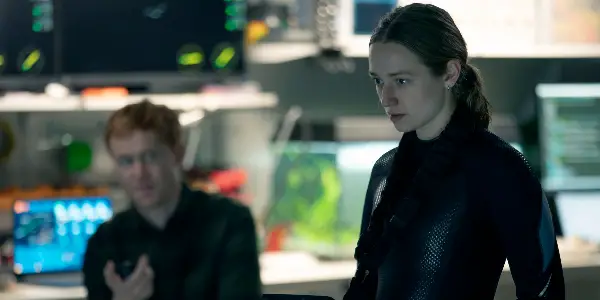
Speaking of that realism, the robots in the film are real — or, at least, based on ones from a real robotics company.
John Andreas Andersen: They’re real!
How closely did you work with that company, and how involved were they in production?
John Andreas Andersen: When we started working on the film and working on the script, we knew we would, of course, go underwater. And to this depth and in this age, [people] don’t really dive anymore. At least, in the ’70s and ’80s, it was all physical diving, but now it’s all ROVs [remotely operated underwater vehicles] going underwater. But then we just found this company in Trondheim in the north of Norway. There are these ingenious guys who’d been working on these robots since they were at school and then developing it, and we had to think, that’s perfect. It’s like a character in the film, almost. So we contacted them, and we were just really happy that they wanted to come on board and help us with it. With the robot, they gave us a lot of props, and really this was, I think, a great motivational thing for them as well, so I think they’re all very happy now.
Because so much of your team worked on The Wave, which also has these half-sunken sets, and The Burning Sea takes place in the open ocean with submerged sets, what were your challenges, as a filmmaker, of working in those conditions? Because it seems terrible.
John Andreas Andersen: Yeah, it is terrible. You’re right! [laughs] The thing is, we ended up shooting this whole film on location. There’s nothing, really, built-in studio, and of course, it gives realism to the film, which I’m happy about, but it is very difficult to get access to these locations, you know? In terms of safety and security and the logistics of getting a film crew on an oil rig, it’s quite an undertaking. When you have an actress that can stand on an oil rig, who can smell the salt and the sea, who can feel the breeze and the weather, the oil is real, everything is real, it also helps the actors, which I’m happy about.
These two films you’ve directed have more of a documentary feel than The Wave and most other disaster films. The camerawork is shakier, closer to the characters… what was your approach with the documentary aesthetic?
John Andreas Andersen: I think reality was important to me, in both of those films. I think The Quake was probably slightly more technical and maybe a little bit more polished than The Burning Sea, and also on The Burning Sea, we went back to shooting on film. Like, good old-fashioned celluloid film, which I wanted because we wanted to get more of that documentary “real” feel, and I think the film just looks fantastically cool going into an industrial location. With film, it just looks fantastic right off the bat, but with digital, it’s more work, so that was part of the initial approach.
Is it difficult to make a dramatic film where so much of the drama and tension comes from characters looking at screens and data on screens?
John Andreas Andersen: Oh, yes. [laughs] The control room in The Burning Sea, I think there are 74 screens, and every one of those 74 screens needs to be aligned with the certain point in the script that we are [at] right at that particular point, so just planning that and designing that — and again, making it also look real for people that are in the oil industry — that was obviously quite a bit of work.
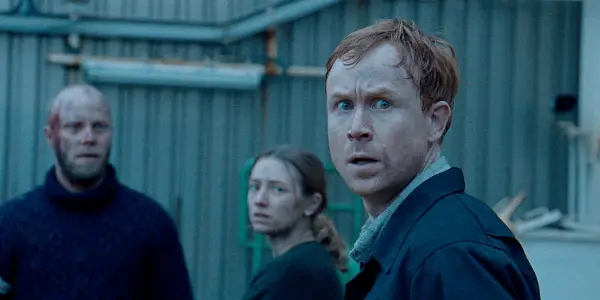
The film opens and closes with these 4:3 almost video cassette-style interviews with the oil executive (Bjørn Floberg) talking about where everything went wrong. What was the inspiration behind bookending the film like that?
John Andreas Andersen: The inspiration for me was, I watched all [these] interviews with oil workers. Originally, I had a plan of also using interviews like that in the film. But then, of course, with COVID and everything… and this was at a point where no one was vaccinated, so I couldn’t really go to 90-year-old oil workers and interview them when there was no vaccine. But still, I was inspired by that, so I wanted to put my actor into that role and have it feel like an interview.
So you’ve already made a film about an earthquake and one about an oil spill. Are there any natural disasters you’d like to work with next?
John Andreas Andersen: I think actually, I’ve done my fair share now of these disaster films. So I’m looking in a slightly different direction coming up next.
Since you inherited the disaster movie, sort of, making a sequel to The Wave, I wondered if you felt like your next project is beholden to that action-thriller model, or if you’re keen to break out and do something more intimate than that?
John Andreas Andersen: Eh, not necessarily “intimate,” but as I said, I think I’m not gonna do another disaster movie next. I had great fun doing these two films, and I think Burning Sea is actually less of a disaster movie than The Quake. But my background is as a cinematographer, as a DP. I did that for 20 years and did all sorts of different films, so I’m not really… I don’t feel like I’m stuck in one genre.
Film Inquiry would like to thank John Andreas Andersen for taking the time to speak with us!
The Burning Sea is in theaters and available on-demand and on digital platforms.
Does content like this matter to you?
Become a Member and support film journalism. Unlock access to all of Film Inquiry`s great articles. Join a community of like-minded readers who are passionate about cinema - get access to our private members Network, give back to independent filmmakers, and more.
Film critic, Ithaca College and University of St Andrews graduate, head of the "Paddington 2" fan club.









